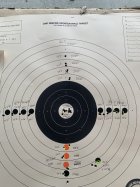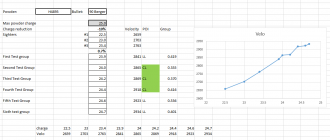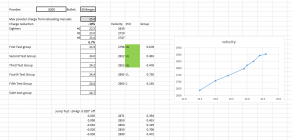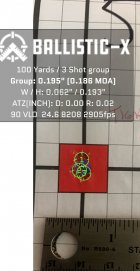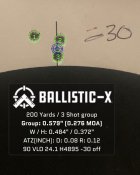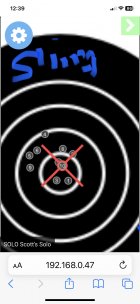Looking through the archives I see I should tag
@Ned Ludd as he seems to be the guru of all things 90 VLD and 223 FTR.
I don't know about that, I have some experience with heavies in the .223 Rem for F-TR. But there are a number of individuals here that also have extensive experience and success shooting a .223 Rem with heavies, again mostly connected with use in F-TR matches.
For the OP- From your desciption above, it sounds like you will be a bit on the short side for 88 ELDMs. IMO - "ideal" freebores would be about 0.210" to 0.220" for the 90 VLD, and maybe 0.250"-ish for the 88 ELDM. This would put the boattail/bearing surface junction about 1/4th or 1/3rd of the neck length above the shoulder, which is where I like it to be. I've run the 90 VLDs for years out of the 223 Rem ISSF chamber (PTG), which has 0.169" freebore. It works, but pressures will run higher at a given velocity than they would with a longer (more appropriate) freebore. Likewise, I have run the 88s from a chamber with 0.220" freebore. It also works, but again, they are seated deeper in the case than is optimal IMO, and pressure will run a bit higher than it would with a longer freebore.
The above info on freebore length may be a bit beyond what the OP is asking, but I mention it because the true limiting factor in my hands when loading heavies in the 223 Rem is poor brass life. The cost of running quality brass like Lapua when you're only getting 2, 3, or maybe 4 firings on a few of the pieces before the primer pockets are trashed gets old pretty quickly. When something is right at the margin, even small things can have a big impact. For example, running a slightly longer freebore may not have much effect in certain other cartridges where the optimal loads aren't at or slightly over MAX pressure. But it does in the .223 Rem. Likewise, running a 0.219" bore barrel seems to lower the start pressure a bit, probably due to a lesser engravement force on the bullet bearing surface. Even a few little things like this can help with brass life for those choosing to run stout loads.
I should add here that the 0.219" bore also has the added benefit of minimizing the potential for jacket failure.
For the OP, jacket failure is
likely to be an issue with both of your bullet choices if the barrel you're running has 0.218" bore and you continue to run what I would call the high node with 88s and 90s. As it turns out, jacket failure is primarily a product of friction, and so bore diameter, barrel length, twist rate, bullet bearing surface length, velocity, the type of rifling, jacket thicknees, and probably a few other factors all can be factors. Without going into further detail, running certain manufacturer's heavy .224" bullets at velocities in the neighborhood of 2850 fps from a 30" barrel with a 7.0 twist or faster is likely to cause jacket failures at some point. I have had issues with jacket failures using both Berger 90 VLDs and the Hornady 88 ELDMs. Like the issue of poor brass life I mentioned above, jacket failure is also a product of pushing heavies very hard in a 223 Rem.
Both issues can be solved by running loads at the next lower node, but many F-TR shooters, myself included, find it hard to do this. However, I have lately begun using slower loads, largely because replacing Lapua brass after two or three firings has simply become too painful. It's not just expensive, it also requires a lot of extra work working up virgin brass so often. If one is
realistic about what we're trying to do with the 223 Rem by pushing 88-90gr+ bullets at velocities in excess of 2800 fps from this relatively small cartridge, we're really asking a LOT. As it turns out, one can run 90 VLDs from a 30" barrel with H4895 at around 2775 fps, and they shoot very well indeed. The difference in predicted windage is less than 1" at 600 yd, so it's not like one has to give up a huge amount of performance to essentially completely mitigate the issues with poor brass life and jacket failures. However, it's not my place to try and tell people what loads they should be running, so I'll leave it at that.
For the OP - a recent [average] COL measurent with 90 VLDs for a relatively new barrel (100 rounds) at "touching" was 2.647". This rifle was chambered with the 223 Rem ISSF reamer (i.e. 0.169" freebore), and the difference between your measurement and mine might suggest your freebore could be a bit longer than 0.185", perhaps as much as 0.220". That seems to be in a bit of disagreement with your comparative measurements in the Wylde chamber, so I'm not really sure what to tell you. There are also the caveats of different bullet Lot#s, actual round count, and the fact that I use a Hornady comparator insert, which has a much smaller diameter hole than many other brands, so the [average] CBTO measurement of 2.054" recorded with the COL listed above seems to have little meaning for comparison. Another method for making a crude estimate might be to look at the location of the boattail/bearing surface junction. When seated at approximately .020" off the lands for the 223 Rem ISSF chamber, a 90 VLD's boattail/bearing surface junction will be only a tick above the neck/shoulder junction, maybe a few thousandths above at most. If the boattail/bearing surface junction of a 90 VLD seated at "touching" is well above the neck/shoulder junction, perhaos even as much as halfway out the neck, you could make a crude estimate using neck length.
In the grand scheme of things, I'm not sure it really matters. I also really like knowing the specs of my equipment, so I get it. But the freebore you have is the freebore you have. There are certainly means to obtain more accurate measurements, but knowing a specific freebore length will not change your loading requirements.
As far as using 8208 XBR, I tested it years ago. I did not end up using 8208 in competition loads for a variety of reasons that include that it was predicted to tune in at a noticeably slower velocity than H4895, and that it is probably more temperature-sensitive than H4895, which is not at all to say that it couldn't work very well. It would require more extensive testing than I did at the time to know that with certainty, however. The following is from some preliminary testing I did using a slightly reduced load with each powder (23.5 gr), which I then used to predict
optimized loads for each using OBT Node 4 barrel time for a 30" barrel as a guide (1.3684 ms):
barrel length = 30", bullet OAL = 1.248", COL = 2.633", case trim length = 1.750", case vol. = 31.11 gr, temperature = 70.0 F
------------------------------------H4895----------------------8208 XBR
Charge weight (gr)----------------24.2--------------------------23.9
Adjusted Ba---------------------0.5496-----------------------0.6163
Pressure (psi)--------------------57,348-----------------------57,754
Barrel Time (ms)------------------1.374------------------------1.372
Velocity (fps)----------------------2853-------------------------2818
Sorry, this data was generated in 2015 and I apparently didn't record the fill ratios. Nonetheless, it should give you some idea of where to start testing with 8208. I can't see any good reason not to try it; I'm about to do the same thing with VV N135, largely to develop a practice load that doesn't burn up my stock of H4895. H4895 is kinda hard to find right now, as I'm sure most readers already know, and none of us know when it will be available again. So testing an alternative powder is a pretty smart thing to do IMO. As with H4895, the biggest question is how hard to push things. As I noted above, for what are really pretty minimal gains in terms of predicted wind deflection, running the higher node is extremely hard on brass, and may also increase the potential for jacket failure. On the other hand, the gains are not zero, so one has to decide for themselves how they wish to approach things.
In any event, best of luck with it. Feel free to ping me if you have other questions.










